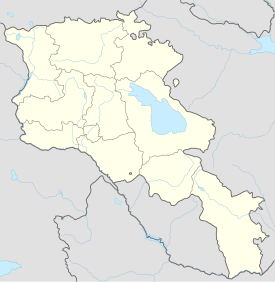This article needs additional citations for verification. (October 2019) |
Շենգավիթ բնակատեղի | |
 Stone foundations of Shengavit Settlement. | |
| Alternative name | Shengavit |
|---|---|
| Location | Corner of Bagratuniats St. and Shengavit St. overlooking Yerevan Lake, Shengavit District, Yerevan, |
| Region | Armenian Highlands |
| Coordinates | 40°09′25″N 44°28′37″E / 40.156965°N 44.476862°E |
| Type | settlement |
| Area | 6 ha (15 acres) |
| Height | Site sits approximately 30 metres (100 ft) above the Hrazdan River |
| History | |
| Material | stone (foundation/lower walls), adobe brick (upper walls), |
| Abandoned | Last quarter of the third millennium BC |
| Periods | Early Bronze Age |
| Cultures | Kura-Araxes Culture |
| Site notes | |
| Excavation dates | 1936-1938, 1958-1980, 2000-2008, 2009-2010, 2012 |
| Archaeologists | Yevgeny Bayburdyan (1936-1938), Sandro Sardaryan (1958-1980), Hakob Simonyan (2000-2008), Mitchell S. Rothman (2009-2010, 2012) |
| Condition | Extant foundations |
| Ownership | City of Yerevan, public property |
| Management | Shengavit Historical & Archaeological-Preserve; entry fee required (1000 AMD museum & grounds + 2000 AMD personal tour guide for RA citizens) |
| Public access | Yes |
| Website | http://www.erebuni.am/index.php?option=com_content&view=article&id=1243&Itemid=685&lang=en |
| Active excavation | |
The Shengavit Settlement (Armenian: Շենգավիթ հնավայր, Shengavit' hənavayr) is an archaeological site in present-day Yerevan, Armenia located on a hill south-east of Yerevan Lake. It was inhabited during a series of settlement phases from approximately 3000 BC cal to 2500 BC cal in the Kura–Araxes (Shengavitian) period of the Early Bronze Age and irregularly re-used in the Middle Bronze Age until 2200 BC cal. The town occupied an area of six hectares. It appears that Shengavit was a societal center for the areas surrounding the town due to its unusual size, evidence of surplus production of grains, and metallurgy, as well as its monumental 4 meter wide stone wall. Three smaller village sites of Moukhannat Tepe, Khorumbulagh, and Tairov have been identified and were located outside the walls of Shengavit. Its pottery makes it a type site of the Kura-Araxes or Early Transcaucasian Period and the Shengavitian culture area.[1]
- ^ "Hakop Simonyan, Shengavit: an Early Transcaucasian Site in Yerevan on the Ararat Plain, Republic of Armenia". Archived from the original on 2008-05-09. Retrieved 2009-09-11.
